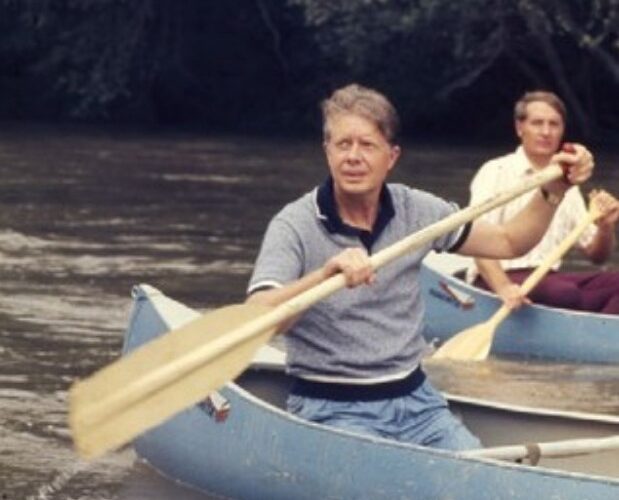2019 marked 25 years since the beginning of Chattahoochee Riverkeeper’s efforts to keep watch over the river with comprehensive water quality monitoring, trash cleanups, educational programs and advocacy efforts.
In celebration of our silver anniversary, we embarked on the Relay Down the Hooch, a momentous 435-mile Olympic-style relay from the Chattahoochee’s source spring in the North Georgia mountains all the way down to Lake Seminole at the Florida border. It took months of hard work, but the Relay reached its southern terminus on Thursday, December 9, 2019.
With the help of 33 partner organizations and hundreds of volunteers, participants carried the custom sassafras paddle, which served as the Relay’s symbolic baton, along the entire length of the river. The project highlighted the countless ways people experience the Chattahoochee and embraced hikers, tubers, paddlers, anglers, sailors, and boaters alike. Unfortunately, throughout the upper segments of the Relay, signs of floating trash and man-made debris were all too visible, despite the best efforts led by Tammy Bates, CRK Outings and Events Manager, who has empowered more than 1,850 volunteers to collect 50 tons of trash in 2019 alone.
“We hope that the Relay will help raise awareness of the issues this area faces,” said Bates. “I’d encourage everyone to be considerate when exploring the river – leave no trace, but also leave it better than you found it. If everyone pitches in by bringing a garbage bag and picking up trash, we’ll make a real positive impact.”
However, it’s not just recreationalists who are responsible for the river’s health. Travelling down the river, Relay participants saw evidence of industries that depend on the Chattahoochee’s waters. Wastewater treatment plants return treated water back into the river at around 163 outfalls along the length. Alabama Power’s Farley Nuclear Plant releases coolant water into the river near Columbia. Toxic coal ash waste has leeches into groundwater near Plant McDonough. And sediment from construction and land-clearing operations remains the most prevalent pollutant in the river. Industries along the river still have a long way to go to minimize their impacts on the environment.
The Relay allowed CRK staff and participating partners the opportunity to mix work with recreation while patrolling stretches of the river not frequently observed. Along the Georgia-Alabama border, CRK staff was shocked by how invasive vegetative species like hyacinths had overtaken the river. Particularly disturbing was the fact that these species first appeared farther north than expected. Additionally, at several points along the journey, CRK staff took samples at suspected contamination sites and took note of potential permit violations that may be affecting the quality of the water.
Besides its scientific value, the Relay Down the Hooch was an important occasion to bring together the community surrounding the river and rally support for the issues it faces. The Chattahoochee touches three states, countless communities, and more than five million people who depend on it for drinking water. On top of that, the river’s importance as a crucial wildlife habitat, a cultural focal point, and a resource for nature-lovers cannot be overstated.
“Our Relay Down the Hooch demonstrated the incredible diversity that exists not just within the people, organizations, and industries that rely on the river, but within the river itself,” said Riverkeeper Jason Ulseth. “We carried our paddle from the North Georgia mountains where the river is just a trickle by the Appalachian Trail, all the way down to Lake Seminole, where it widens out and coastal plants and wildlife begin to make an appearance. Regardless of where we were along the river, I was always amazed at the true beauty of our river system.”



